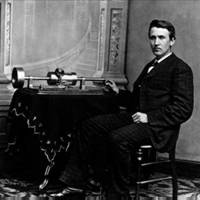
The first sounds were recorded and reproduced by the American inventor Thomas Alva Edison in 1877, in the contraption he later refined and marketed as a phonograph (sound writer). It used a horn with a diaphragm at a narrow end as both a microphone and loudspeaker. When someone spoke or rang into the horn, the diaphragm – and a steel needle attached to it – vibrated up and down. The record was a sheet of tinfoil wrapped round a cylinder with the spiral groove cut in its edge surface. To record, the cylinder was turned by a handle. Sounds entering the horn vibrated the needle, which moved along the spiral groove and indented the tinfoil as it did so. To play the recording, the cylinder was turned again, and as the needle followed the indentations in the tinfoil, it vibrated the diaphragm, causing sounds to emerge from the horn.
German born Emile Berliner, working in the United States, made the vital break through in sound recording in 1888 when he introduced the record disc. It was played on a turntable using the same type of horn and needle as the phonograph. Berliner called his machine the gramophone. Four years later he pioneered the technique of copying discs by electroplating and stamping. Previously, each disc or cylinder had to be recorded separately – a performer might have to record the same song hundreds of times. Berliner’s shellac 78rpm disc remained the standard until 1948.
Picture Credit : Google

